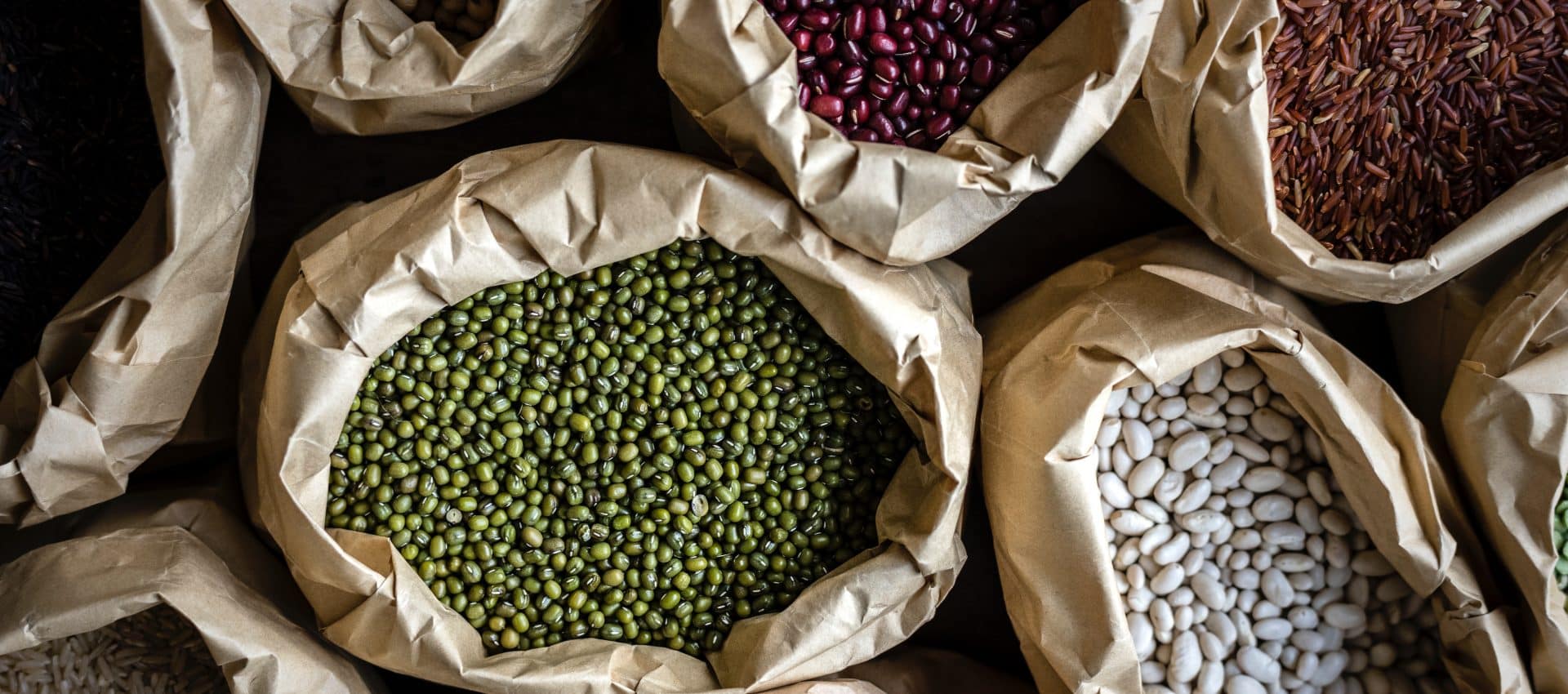Legumes and pulses are rich in vitamins and protein. A staple ingredient in many regional diets, this food group offers a plethora of benefits. ProVeg looks at why legumes are such a healthy source of protein and other nutrients.
What are pulses?
Pulses are part of the legume family (any plants whose seeds grow in pods), but the term refers only to the dry edible seed within the pod. Beans, lentils, chickpeas, and split peas are the most common types of pulses. Peanuts, soya beans, and fresh beans and peas are legumes but are not considered pulses.
Pulses and legumes are healthy sources of protein and vitamins
Pulses and legumes are rich in B vitamins, iron, copper, magnesium, manganese, zinc, and phosphorus. They also supply dietary fibre, carbohydrates, and protein. Pulses are not only low in saturated fat but contain very little fat overall. Like all plant-based foods, they are also cholesterol-free.1 Pulses and legumes are also an excellent source of protein. See the table below for the protein content of various pulses:2
Preventing and treating diseases with pulses
Due to their low glycemic index and high fibre content, pulses and legumes can reduce blood sugar levels in patients with type 2 diabetes in both the short and long term and, as part of a balanced diet, can reduce the risk of developing type 2 diabetes.3 4 Eating pulses several times a week or, better still, daily, also has a positive effect on blood pressure. This effect is due mainly to the high content of potassium, magnesium, and fibre. In addition, the consumption of soya beans, chickpeas, lentils, and other legumes can also help increase the feeling of satiety for an extended period of time due to their high content of protein, fibre, and carbohydrates, which increases blood sugar levels more slowly.5 6
Pulses are a healthier source of protein than animal-based food
On average, plant-based foods contain smaller quantities of essential amino acids compared to animal-based foods, with a few exceptions, including soya beans and hemp seeds.7 8 However, the biological value of dietary proteins can be increased considerably by combining different protein-containing foods as the amino acids they contain complement each other.9 10 11 Ideally, pulses should be combined with cereals, nuts, seeds, and vegetables, which can also be eaten throughout the day. 12 13 The digestibility of pulses’ plant-based protein can be significantly enhanced by cooking, chopping, or soaking them.14 A plant-based diet containing regular servings of pulses can provide more than sufficient protein. This is also true pregnancy or periods of strenuous physical activity, both of which require an increase in protein consumption.
In addition to their protein content, the presence of vitamins, minerals, fibre, phytochemicals, carbohydrates, and fats also determines how healthy certain foods are. In these terms, plant-based sources of protein generally perform better than animal-based ones as the latter often contain many unhealthy saturated fats and not as many vitamins, minerals, fibre and phytochemicals. The consumption of animal protein can have several other adverse health effects: increased consumption of red meat, for example, can elevate the risk of developing diabetes and high blood pressure.15 16 High meat consumption is also linked to some forms of cancer.17
Pulses are also suitable for athletes
Their high protein and carbohydrate content makes legumes a good source of energy for people who engage in competitive or endurance sports since their carbohydrates are digested slowly, thus providing the body with energy for several hours.18 19 After workouts, it is recommended to consume proteins in conjunction with carbohydrates, which lead to the release of insulin. This has a favourable effect on muscle growth due to the anabolic hormonal effect of insulin.20
Pulses are highly versatile in the kitchen
Due to the large variety of pulses, there are numerous ways to cook with them. Pulses are used in many Indian and Asian dishes. Most legume-based Indian dishes are also generally vegetarian or vegan. Lentils are ideal for vegetable soups or casseroles, for example, while chickpeas can be turned into delicious hummus or a crispy, healthy snack by roasting them. Pulses also present a cruelty-free alternative to meat.21 22
Pulses are a healthy meat alternative
More and more people are questioning the consumption of meat and its effects on animals, the environment, and our health. This is reflected in the increasing demand for meat alternatives. Many supermarkets now offer a wide range of meat alternatives based on legumes.23 Soya beans are used to produce tofu, tempeh, and soya meat, which are particularly popular alternatives to conventional meat. There are also numerous varieties of tofu, including smoked and marinated products flavoured with various herbs and spices. Soya meat (also called textured soya protein) is also available in various forms. Soya strips can be used for plant-based gyros or shawarmas, while soya mince is a great choice for chilli sin carne or veggie bolognese. Black bean burgers are a popular, healthy, and tasty alternative to ready meals and unhealthy fast food, while lupin protein is used to produce cutlets and sausages, among other things.
ProVeg tips for legumes
- Pulses are a healthy source of protein and a practical alternative to meat. Pulses and legumes, including lentils, beans, peas and lupins, as well as products made from them, such as tofu, soy milk, or tempeh, should be consumed several times a week.
- Incorporating legumes into your diet can stabilise your blood sugar levels and help you feel full for a long time. Since their carbohydrates pass into the blood slowly, pulses are particularly suitable for type 2 diabetics, and also help to prevent diabetes.24
- If you suffer from high blood pressure, you should incorporate pulses into your diet since they help to regulate blood pressure.25
References
- Polak, R., Phillips, E. M. & A. Campbell (2015): Legumes: Health Benefits and Culinary Approaches to Increase Intake. Clin Diabetes. Online at: https://www.ncbi.nlm.nih.gov/pmc/articles/PMC4608274/ [24.05.2018]
- United States Department of Agriculture: USDA Food Composition Databases, Online at: https://ndb.nal.usda.gov/ndb/search/list [24.05.2018]
- Becerra-Tomás, N., Díaz-López, A. & N. Rosique-Esteban et al. (2017): Legume consumption is inversely associated with type 2 diabetes incidence in adults: A prospective assessment from the PREDIMED study. Clin Nutr. Online at: https://www.ncbi.nlm.nih.gov/pubmed/28392166 [04.06.2018]
- WHO (2016): Global Report on Diabetes. S. 36. Online at: http://apps.who.int/iris/bitstream/handle/10665/204871/9789241565257_eng.pdf%3Bjsessionid=131F7670AEBC4F39A3290A0D0A0E6D11?sequence=1 [04.06.2018]
- Kristensen, M. D., Bendsen, N. T., Christensen, S. M., Astrup, A. & A. Raben (2016): Meals based on vegetable protein sources (beans and peas) are more satiating than meals based on animal protein sources (veal and pork) – a randomized cross-over meal test study. Food Nutr Res. Online at: https://www.ncbi.nlm.nih.gov/pmc/articles/PMC5073301/ [04.06.2018]
- Polak, R., Phillips, E. M. & A. Campbell (2015): Legumes: Health Benefits and Culinary Approaches to Increase Intake. Clin Diabetes. Online at: https://www.ncbi.nlm.nih.gov/pmc/articles/PMC4608274/ [24.05.2018]
- Henkel J. (2000): Soy. Health claims for soy protein, questions about other components. FDA Consum. 34(3):13–15,18–20.
- Mangels, R., Messina, V. & Messina, M. (2011): The Dietitian’s Guide to Vegetarian Diets (3rd edition). p. 71
- Young, V. R. & P. L. Pellett (1994): Plant proteins in relation to human protein and amino acid nutrition. Am. J. Clin. Nutr. 59, p.1203S–1212S
- Marsh, K. A. et al. (2013): Protein and vegetarian diets. Med. J. Aust. 199, p.S7–S10
- Tomé, D. (2013): Digestibility issues of vegetable versus animal proteins: Protein and amino acid requirements – functional aspects. Food and Nutrition Bulletin. 34, p.272–273
- American Heart Association (2016): Vegetarian Diets. Online at: www.heart.org/HEARTORG/HealthyLiving/HealthyEating/Vegetarian-Diets_UCM_306032_Article.jsp#.WdZOFdNJbBI [05.07.2018]
- Sanders TA (1999) The nutritional adequacy of plant-based diets. Proc Nutr Soc 58: p. 265–269
- Mangels, R., Messina, V. & Messina, M. (2011): The Dietitian’s Guide to Vegetarian Diets (3rd edition). S. 69
- Feskens, E. J. M., Sluik, D. & Van Woudenbergh, G.J. (2013): Meat consumption, diabetes, and its complications. Curr Diab Rep. 2013;13(2):298–306. Online at: https://www.ncbi.nlm.nih.gov/pubmed/23354681 [24.05.2018]
- Melina, V., Craig, W. & S. Levin (2016): Position of the Academy of Nutrition and Dietetics: vegetarian diets. Journal of the Academy of Nutrition & Dietetics. Online at: https://www.ncbi.nlm.nih.gov/pubmed/27886704 [24.05.2018]
- WHO (2015): Q&A on the carcinogenicity of the consumption of red meat and processed meat. Online at: http://www.who.int/features/qa/cancer-red-meat/en/ [26.06.2018].
- Lattimer, J. M. & M. D. Haub (2010): Effects of dietary fiber and its components on metabolic health. Nutrients [Internet]. 2010 Dec 15 [cited 2017 Sep 13];2(12):1266–89. Online at: http://www.ncbi.nlm.nih.gov/pubmed/22254008 [06.06.2018]
- Viguiliouk, E., Stewart, S. E., Jayalath, V. H. et al. (2015): Effect of Replacing Animal Protein with Plant Protein on Glycemic Control in Diabetes: A Systematic Review and Meta-Analysis of Randomized Controlled Trials. Nutrients. Online at: https://www.ncbi.nlm.nih.gov/pmc/articles/PMC4690061/ [06.06.2018]
- aschka, C. & S. Ruf (2012): Sport und Ernährung – Wissenschaftlich basierte Empfehlungen und Ernährungspläne für die Praxis, Georg Thieme Verlag KG Stuttgart
- Bittman, M. (2010): Elevating Simple Legumes, Just Enough. The New York Times. Online at: https://www.nytimes.com/2010/01/06/dining/06mini.html [06.06.2018]
- DAA (2018): Legumes: what are they and how can I use them? Online at: https://daa.asn.au/smart-eating-for-you/smart-eating-fast-facts/food-and-food-products/legumes-what-are-they-and-how-can-i-use-them/ [06.06.2018]
- Schmitt, S. (2017): Marktentwicklung: Das Sortiment wird breiter, In: Lebensmittel Zeitung Lebensmittel Zeitung vom 17.11.2017
- Diabetes UK: Pulses and diabetes. Available at: https://www.diabetes.org.uk/guide-to-diabetes/enjoy-food/eating-with-diabetes/food-groups/pulses-and-diabetes
- American Journal of Hypertension (2013): Effect of Dietary Pulses on Blood Pressure: A Systematic Review and Meta-analysis of Controlled Feeding Trials. Available at https://www.ncbi.nlm.nih.gov/pmc/articles/PMC5391775/



